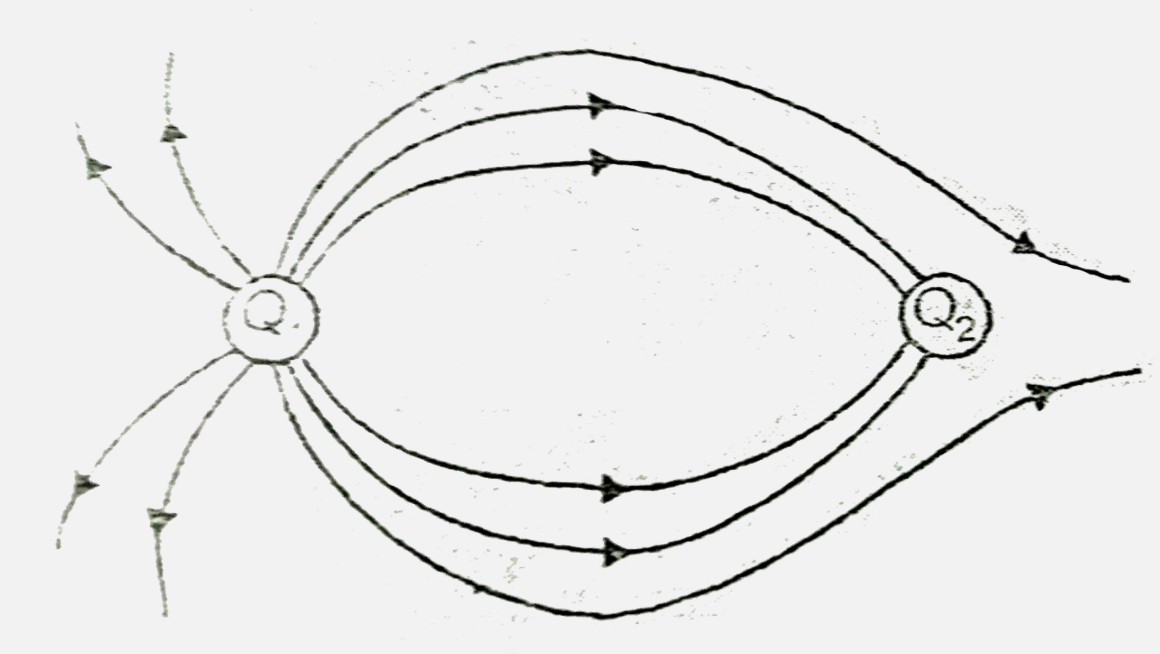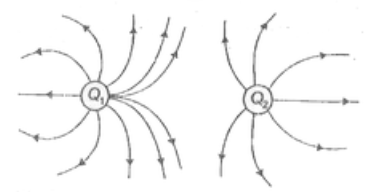Looking at the vanous electric lines of forces between charges and find the value of
To find the value of Q1Q2 based on the electric lines of force between two charges Q1 and Q2, we can follow these steps:
Step 1: Understand the Concept of Electric Lines of Force
Electric lines of force represent the direction and strength of the electric field created by charges. The number of lines of force is proportional to the magnitude of the charge.
Step 2: Count the Lines of Force for Each Charge
From the problem, we need to count the number of lines of force emanating from each charge:
- For charge Q1, we count 10 lines of force.
- For charge Q2, we count 6 lines of force.
Step 3: Set Up the Ratio
The ratio of the magnitudes of the charges can be determined by the ratio of the lines of force:
Q1Q2=Number of lines of force from Q1Number of lines of force from Q2
Substituting the values we counted:
Q1Q2=106
Step 4: Simplify the Ratio
We can simplify the fraction:
Q1Q2=106=53
Step 5: Consider the Polarity
Since the problem states that Q1 and Q2 are opposite in polarity, we can express the ratio with a negative sign:
Q1Q2=−53
Final Answer
Thus, the value of Q1Q2 is:
Q1Q2=−53
Electric lines of force represent the direction and strength of the electric field created by charges. The number of lines of force is proportional to the magnitude of the charge.
From the problem, we need to count the number of lines of force emanating from each charge:
- For charge Q1, we count 10 lines of force.
- For charge Q2, we count 6 lines of force.
The ratio of the magnitudes of the charges can be determined by the ratio of the lines of force:
Q1Q2=Number of lines of force from Q1Number of lines of force from Q2
Substituting the values we counted:
Q1Q2=106
We can simplify the fraction:
Q1Q2=106=53
Since the problem states that Q1 and Q2 are opposite in polarity, we can express the ratio with a negative sign:
Q1Q2=−53
Thus, the value of Q1Q2 is:
Q1Q2=−53
Similar Questions
Looking at the various electric lines of forces between charges Q1 and Q2 , find the value of Q1Q2

View SolutionFigure shows electric lines of forces due to charges Q1 and Q2 Henice


View SolutionThe electrostatic force between two charges Q1andQ2 at separation r is given by F=K.Q1Q2r2 The constant K
View SolutionThe figure is a plot of lines of force due to two charges q1andq2. Find out the sign of charges.

View SolutionThe given figure gives electric line of force due to two charges q1 and q2. What are the signs of the two charges ?

View SolutionThe figure shown is a plot of electric field lines due to two charges Q1 and Q2 . The sign of charges is

View SolutionIdentify A and B:

View SolutionThree equal charges are placed on the three corners of a square. If the force between q1 and q2 is F12 and that between q1 and q3 is F13, then the ratio of magnitudes (F12/F13) is
View SolutionIn the following question a statement of assertion (A) is followed by a statement of reason (R )
A : Two large conducting spheres carrying charges Q1andQ2 are brought close to each other. The magnitude of electrostatic force between them is exactly given by Q1Q2/4πε0r2 , where r is the distance between their centres.
R: Here charges Q1andQ2 can be assumed to be concentrated at the centres of their respective spheres.
View SolutionA charge Q located at a point →r is in equilibrium under the combined field of three charges q1,q2 and q3. If the charges q1 and q2 are located at point →r1 and →r2 respectively, find the direction of the force on Q due to q3 in terms of q1,(q2),→r1→r2, and →r.
View Solution
